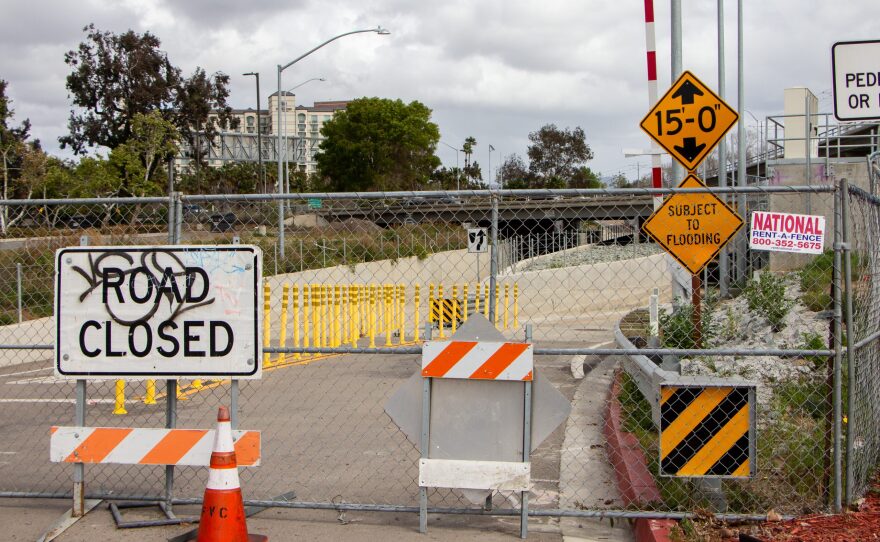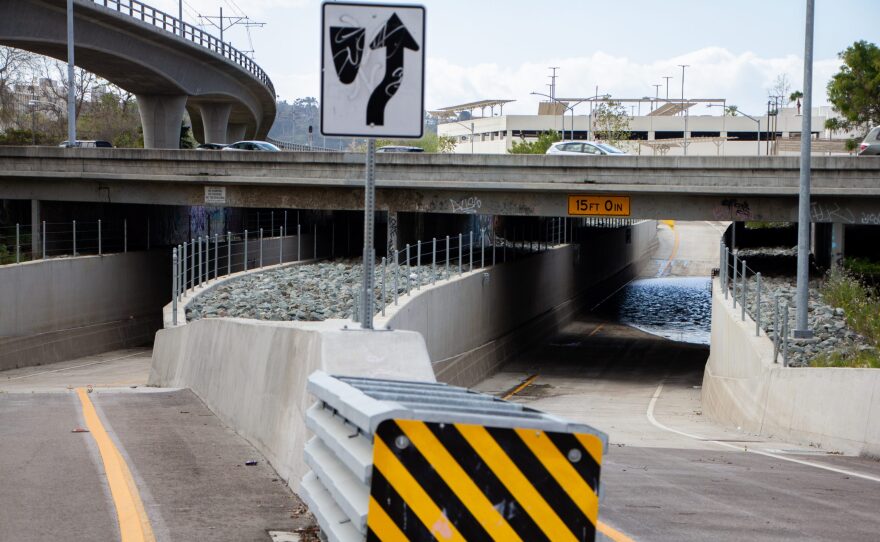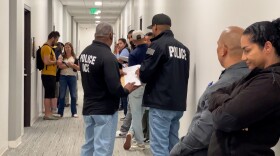Chain-link fencing, traffic cones and construction signs have long prevented vehicles from traveling under State Route 163 along a short stretch of Hazard Center Drive promised years ago to provide much needed relief for traffic congestion on roads surrounding shopping areas in Mission Valley.
On a recent Saturday morning, water pooled at the deepest point in the roadway, which lies adjacent to the San Diego River.
The never-before-used underpass, which in most respects appears ready for traffic, is in fact more than 30 years in the making.
It’s been the subject of lawsuits, including one that dragged on for nearly a decade, an eyesore to residents in the community and an enigma to those who have passed and wondered the obvious: Why isn’t it open?
Known officially as the westerly extension of Hazard Center Drive, the idea originated in the 1980s as a condition of the Hazard Center redevelopment project as the area was transitioning from a brickyard to a commercial center in a neighborhood known today for its sprawling parking lots and congested roads. The road extension was pitched as a way to reduce the traffic congestion predicted at the time and affecting the area now.
But, as the property passed through the hands of various developers, the question of who exactly was responsible for building the road became more complicated.
An eight-year legal battle ensued to answer that question and ended in a confidential settlement between two developers late last year. Which developer is responsible for paying for the road remains unknown to the public and the city.
Delays in the road’s opening have held up construction of a 473-unit residential building in Hazard Center. Meanwhile, Mission Valley’s population is expected to reach more than 70,000 by 2050, tripling from its 2012 population in four decades, further straining infrastructure in the area.
After years of assurances to the public that the underpass was months away from being opened, it remains as closed as ever to drivers. The city said it is not involved with the project and is only responsible for inspecting the roadway before it’s opened.
The current owner of Hazard Center, who said he’s spent millions on the project, said the road could be just months away from completion, but residents aren’t so convinced.
“Why did they even spend the money to do it? What do they do with it?” Debbie Meyer, a 69-year-old Mission Valley resident, said while on a walk with her husband.
“We have said that to one another a million times when we walked by here.”
From bricks to buildings
Hazard Center is a strip mall development boasting chain restaurants, shopping, a hotel, nail salon and more, nestled in the center of Mission Valley where State Route 163 crosses over the San Diego River. But in the 1980s, the area looked much different.
Hazard Center was in the midst of a transition from a brickyard to what city planners envisioned would be a “progressive mixed-use project combining shops and restaurants, a hotel, office tower and a multifamily residential neighborhood.”
The westerly extension of Hazard Center Drive, which once open will connect Hazard Center to Fashion Valley, was a part of that plan from nearly the beginning.
In 1987, the city approved plans for the redevelopment of Hazard Center with a requirement that when traffic on nearby roads reached a certain threshold, the developer — R.E. Hazard Contracting Company, at that time — would build the road extension to offset the predicted impacts on traffic that the new development would bring.
Before that could happen, the property changed hands several times over the next 15 years
In 2003, the current owner of Hazard Center, Principal Global Investors, bought the property with plans to build 473 new residential units on the land.
The city has made the completion of the Hazard Center Drive extension a condition of the project’s permit — meaning they couldn’t break ground on the new housing units until the road was opened to the public.
Three lawsuits filed between 2005 and 2017, which have since closed, entangled Principal Global Investors, former owner Connecticut General Life Insurance Company, an affiliate of Cigna, and the city in disputes all leading back to the question of who should be responsible for funding and constructing the road extension.
Connecticut General Life Insurance Company had originally agreed to build the road when is sold the property to Principal Global Investors, but later claimed in court that unforeseen complications in the area planned for the road now made building it nearly impossible.
Sometime between late 2017 and early 2018, Principal Global Investors started construction on the road and sued the Connecticut General Life Insurance Company for the cost of the construction.
By 2021, the legal battles over the Hazard Center Drive extension between the two developers closed in court with a confidential settlement.
Media contacts for Connecticut General Life Insurance Company’s parent company did not return a request for comment.
Neither party is allowed to discuss publicly the terms of the settlement, but Mike Benson, managing director of asset management at Principal Global Investors, which currently owns Hazard Center through an affiliated LLC, said he is working with a construction company to finish the road.
“We want it open more than anyone else does,” Benson said.

Benson said the lawsuits and the COVID-19 pandemic delayed progress on the road, which he said had “taken a lot longer than it should have” and that in turn has blocked progress on the housing complex.
He said he was “optimistic and hopeful that we can get it open in the next month or two” — all he needs is a replacement part for the pumping system — but added that the opening will also depend in part on the city completing inspections.
Tyler Becker, a San Diego public information officer, said the ball was currently in the developer's court.
“The developer needs to complete and get city acceptance of the stormwater pump station and a few other items before the extension can be opened to the public.” Once that happens, the city will be responsible for maintaining the road, Becker said.
When it rains, it floods
Most San Diegans know all too well — in Mission Valley, when it rains, it floods.
It’s common for roads such as Avenida del Rio, which crosses the San Diego River and connects Fashion Valley to Camino de la Reina, to flood to the point of closure after rain. With heavier rain events, the city shuts down roads in the area in anticipation of flooding.
In the past, flooding in Mission Valley has led to rescues and evacuations of residents.
All of that makes building the underpass more complicated, said Rob Hutsel, president and CEO of the San Diego River Park Foundation. Developers who want to build in Mission Valley have to build around flooding events while at the same time mitigating harmful effects like pollution in the river.
“Historically, development has been allowed in Mission Valley and in such a way that the river and the aquifer are impacted by that development,” Hutsel said.
But the Hazard Center extension could provide an opportunity to rethink older roads like Avenida del Rio, Hutsel said — that is, if Hazard Center can open to the public while dealing with flooding and potential effects on the San Diego River habitat.
The morning after Fashion Valley received about a half inch of rain in early March, water pooled in the deepest part of the underpass.
Celina Watson, a 19-year-old who lives in Otay Ranch, said she’d seen the underpass flooded before.
Watson takes the trolley to Fashion Valley and sometimes passes Hazard Center Drive on her way and has wondered why it’s always closed.
“There's not a sign or something, so I just thought it was for safety or something like that,” she said.

Despite the obstacles to building in Mission Valley, the community will likely keep growing, according to an 2019 environmental impact report that predicted Mission Valley would add 50,000 residents by 2050.
That would mean more people using roads and bridges in Mission Valley to get around, and, for more than 30 years, the Hazard Center Drive extension has been part of a solution toward reducing traffic congestion in the area, which residents such as Meyer said had gotten bad.
“You can't even believe the traffic on Camino de la Reina in the afternoon at commute time and on the weekend,” said Meyer, who’s lived in Mission Valley for six years.
Meyer said it “would be incredible” if the roadway opened.
Brian Mooney, senior vice president at Rick Engineering Company, said a lot had shifted in how urban planners develop cities since the extension of Hazard Center was first planned as a solution to traffic in the area.
Newer thinking in planning, which considers the environment and pedestrian traffic, can conflict with older plans and raise new questions about projects envisioned years ago, Mooney said.
The connectivity the Hazard Center Drive extension would provide makes sense for the area, but, he said, “it's like trying to build something on the ocean. Trying to build something adjacent to a river — that creates a whole level of complications because of environmental factors.”





